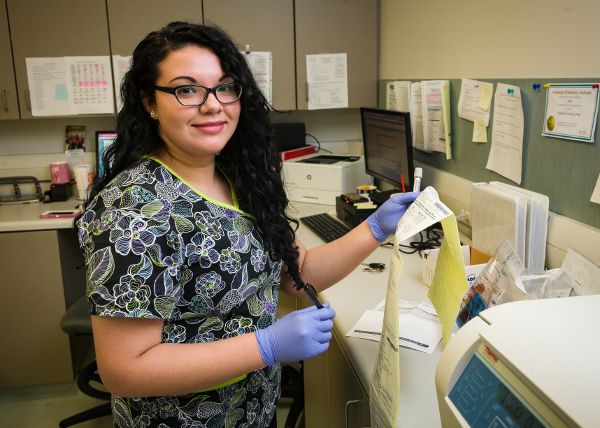Overview
Cervical cancer begins when cells in the cervix start to grow uncontrollably. A tumor can form when more cancer cells develop, and it can spread to other areas of the body. As it grows and spreads, the cancer becomes more advanced.
The cervix is the lower part of the uterus which connects the uterus to the vagina. Nearly all cervical cancers start in the transformation zone, the area between the endocervix (the part of the cervix closest to the body of the uterus) and exocervix (the part of the cervix closest to the vagina). Cervical cancers commonly start as pre-cancers which can be detected by a Pap test.
Types of cervical cancer include:
- Squamous cell carcinomas (About 9 out of 10 cervical cancers are of this type)
- Adenocarcinomas
- Adenosquamous carcinomas or mixed carcinomas
- Rarely, other types of cancer can start in the cervix, including melanoma, sarcoma, and lymphoma
Symptoms
Early cervical cancers and pre-cancers often do not cause symptoms. When cervical cancer becomes malignant and begins to spread, it can cause:
- Abnormal vaginal bleeding
- Unusual vaginal discharge
- Pain during intercourse
It is important to note that the symptoms above can be caused by a number of other non-cancerous causes, but it is important to be checked by a medical professional to improve the chances of effective treatment.
Risk Factors
The most important risk factor for cervical cancer is infection with human papillomavirus (HPV). HPV is common, but in some cases, the body is unable to clear the infection and develops a chronic infection, which can eventually cause cancer by producing proteins which deactivate the tumor suppressor genes that normally regulate cell growth.
Smokers are twice as likely as non-smokers to develop cervical cancer. Tobacco by-products have been found in cervical mucus, and may be damaging to cervical cells; the immune system may also be weakened by smoking and therefore become less effective in combating cancer-causing HPV infections.
Suppression of the immune system, which can be caused by human immunodeficiency virus (HIV) or certain treatments for autoimmune diseases, may increase the risk of HPV infection or allow cervical cancer to develop and spread more quickly.
Long-term use of oral contraceptives increases the risk of cervical cancer, increasing the longer use persists and decreasing after it is stopped, with risk level returning to normal after about 10 years after stopping oral contraceptives. It is important to discuss the benefits and risks of oral contraceptives with your doctor.
The use of intrauterine devices (IUDs) may decrease the risk of developing cervical cancer, and the risk reduction has been observed even after the IUD is removed, and with less than a year of use.
Women who have a full-term pregnancy before the age of 17 are nearly twice as likely to develop cervical cancer than those who do not become pregnant until after 25.
Other risk factors include: current or past chlamydia infection, a diet which does not include sufficient fruits and vegetables, being overweight, having had three or more full-term pregnancies, lacking access to adequate health care and screening services (often due to economic status), fetal exposure to the hormonal drug diethylstilbestrol (DES) (learn more here), and having a family history of cervical cancer.
Prevention
Many cases of cervical cancer can be prevented by detecting and treating pre-cancers. Screening methods include regular Pap tests and HPV tests. Pap tests involve collecting and examining cervical cells, and are often performed during a routine pelvic exam.
There are other recommendations to prevent or lower your risk of cervical cancers and pre-cancers, which include:
- Use condoms, which protect against HIV, chlamydia, and other sexually transmitted infections, and offer incomplete protection against HPV infection (which can be contracted by skin-to-skin contact not necessarily including intercourse).
- Refrain from or stop smoking.
- Receive HPV vaccination if recommended by your doctor. Learn more about the American Cancer Society recommendations for HPV vaccination here.
Diagnosis
While some cervical cancers are found after symptoms like abnormal vaginal bleeding appear, many women are diagnosed with no symptoms at all. For this reason, regular screenings are important for early detection, and regular Pap tests are recommended as part of a regular examination by your gynecologist.
If there is a suspicion of cervical cancer, you should be examined by a gynecologist. A detailed medical history and physical exam will be performed. Your doctor will ask questions about your risk factors and family history. The physical exam will include a pelvic exam and Pap screening.
An abnormal Pap test result is not a diagnostic test for cancer, and additional testing will be required to confirm a diagnosis of cancer or pre-cancer. This testing may include a colposcopy, in which your physician examines the cervix using a speculum and external magnifying scope, and which is no more invasive or uncomfortable than a regular speculum exam. A biopsy — the removal and testing of possibly abnormal tissue — may also be required. Biopsy procedures can be performed under local anesthetic in your doctor’s office, but may cause some discomfort, cramping, or bleeding.
Other tests may be used in addition to the diagnostic tools discussed above.
Treatment
The treatment plan will depend on the stage of the cancer, as well as other factors. Our doctors will work closely with you and your family determine the best treatment plan for you. Options for treatment could include:
- Surgery
- Radiation therapy
- Chemotherapy
- Targeted therapy
- Immunotherapy
Your doctor may decide more than one of these treatment options will be in your best interest. Surgery is a common treatment option.







